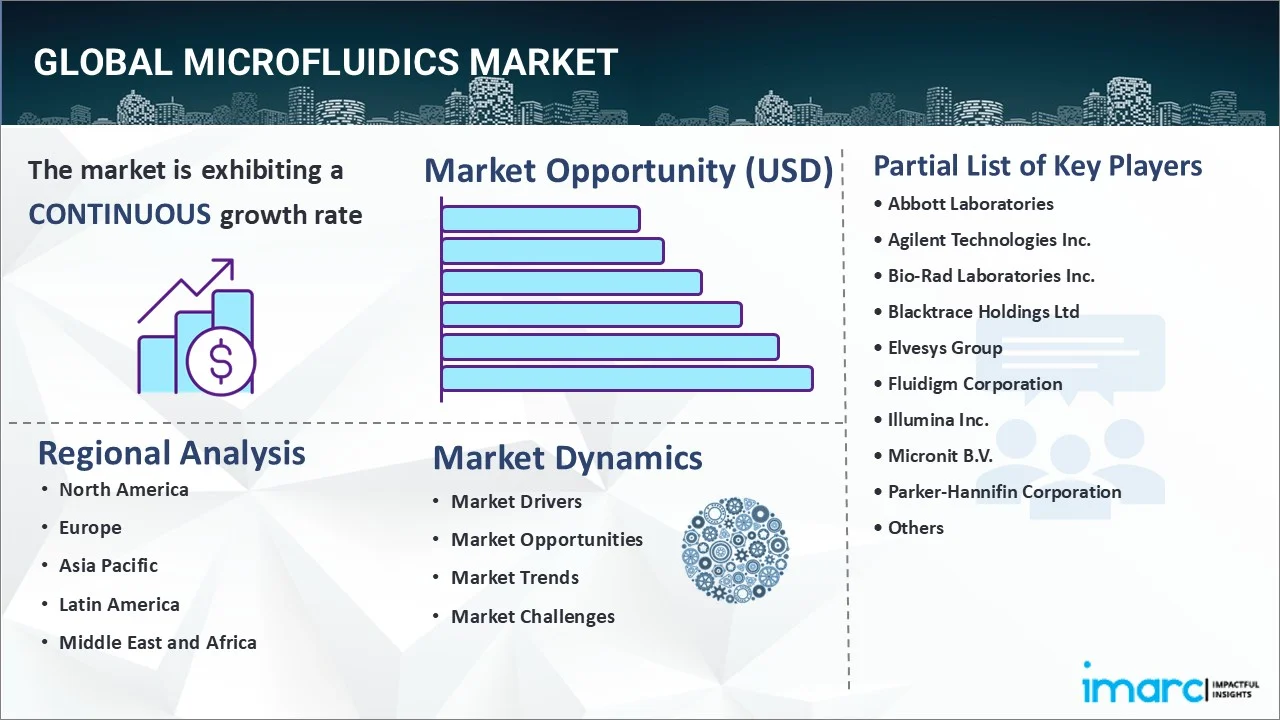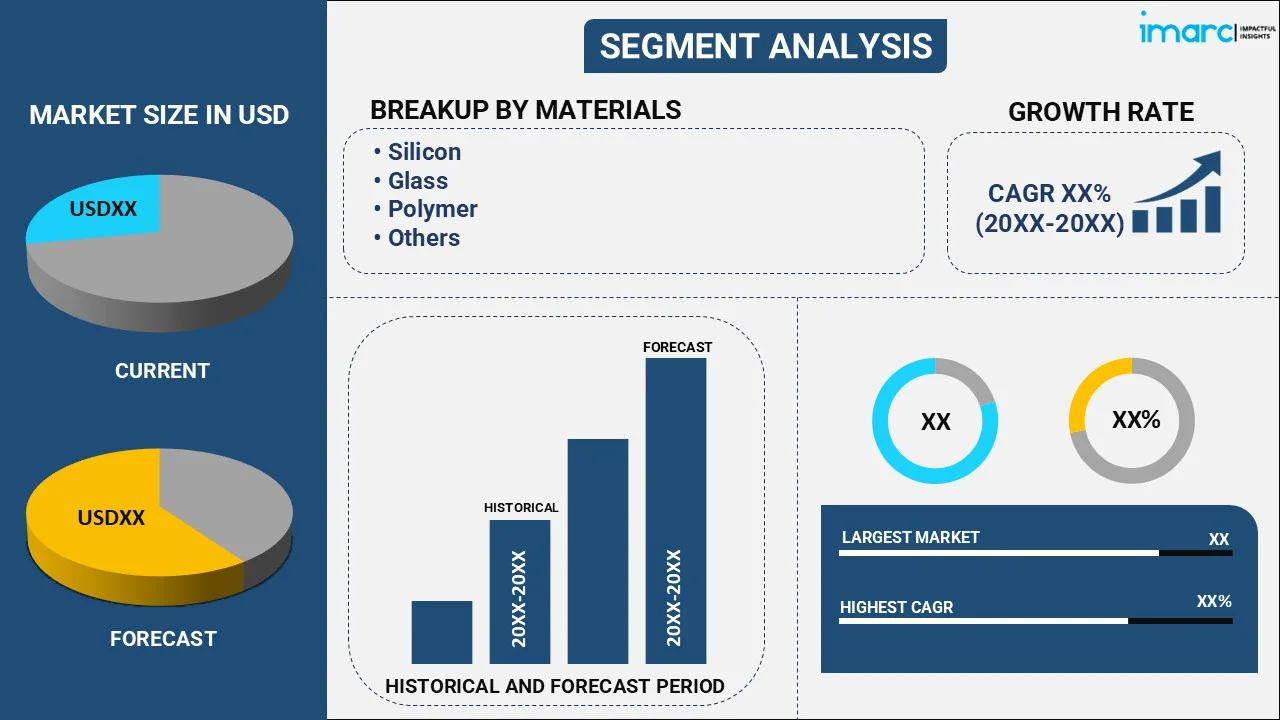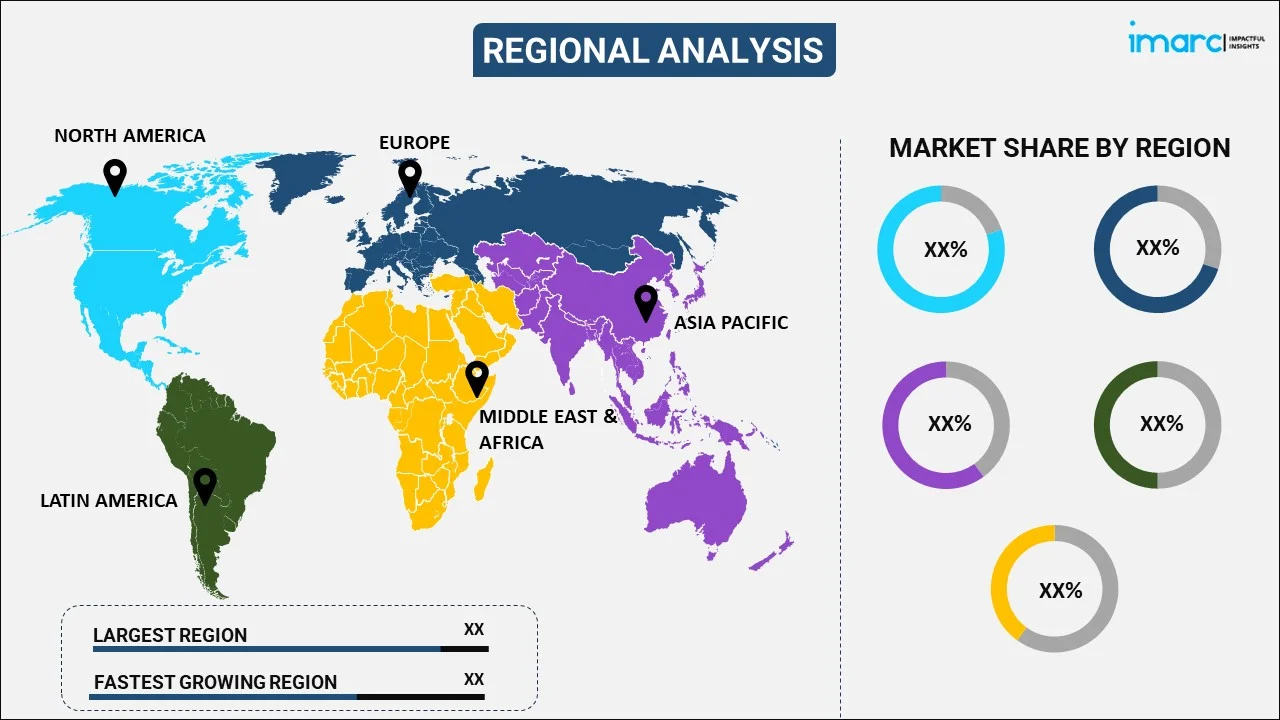
Microfluidics Market Report by Material (Silicon, Glass, Polymer, PDMS, and Others), Component (Microfluidic Chips, Micro Pumps, Microneedles, and Others), Application (Pharmaceutical and Life Science Research, Clinical and Veterinary Diagnostics, Point-of-Care Diagnostics, Analytical Devices, Drug Delivery, and Others), and Region 2025-2033
Global Microfluidics Market:
The global microfluidics market size reached USD 33.1 Billion in 2024. Looking forward, IMARC Group expects the market to reach USD 101.8 Billion by 2033, exhibiting a growth rate (CAGR) of 12.64% during 2025-2033. The increasing demand for quick and accurate diagnostic tools with point-of-care testing technologies is stimulating the market.
|
Report Attribute
|
Key Statistics
|
|---|---|
|
Base Year
|
2024
|
|
Forecast Years
|
2025-2033
|
|
Historical Years
|
2019-2024
|
|
Market Size in 2024
|
USD 33.1 Billion |
|
Market Forecast in 2033
|
USD 101.8 Billion |
| Market Growth Rate 2025-2033 | 12.64% |
Microfluidics Market Analysis:
- Major Market Drivers: The growing focus on personalized healthcare is encouraging the need for innovative solutions in drug delivery and disease management, which is propelling the market.
- Key Market Trends: The advances in miniaturized lab technologies are making complex research and testing more efficient, which is acting as a growth-inducing factor.
- Competitive Landscape: Some of the major market companies include Abbott Laboratories, Agilent Technologies Inc., Bio-Rad Laboratories Inc., Blacktrace Holdings Ltd, Elvesys Group, Fluidigm Corporation, Illumina Inc., Micronit B.V., Parker-Hannifin Corporation, PerkinElmer Inc., Qiagen N.V., and Thermo Fisher Scientific Inc., among many others.
- Geographical Trends: In Asia Pacific, advancements in healthcare and diagnostics are driving growth. In contrast, Europe focuses on drug discovery and personalized medicine and North America emphasizes point-of-care testing innovations. Meanwhile, Latin America sees rising healthcare access, and the Middle East and Africa explore emerging diagnostic technologies and research applications.
- Challenges and Opportunities: The high cost of device fabrication is hindering the market. However, developing cost-effective manufacturing techniques and enhancing material scalability will continue to strengthen the market over the forecasted period.

Microfluidics Market Trends:
Increasing Demand for Cost-Effective Solutions
Microfluidic technologies are gaining traction due to their ability to reduce operational costs. In addition, the compact design and automation of these systems allow researchers to perform complex experiments with fewer resources, minimizing reagent use, equipment expenses, and time, thereby driving widespread adoption in various sectors and elevating the microfluidics market demand. For instance, in September 2024, Dolomite Bio launched Nadia Go, an affordable microfluidic system designed for custom protocol development. This compact, semi-automated platform allows researchers to easily create and test novel single-cell protocols, offering flexibility and accessibility without the need for complex modular systems.
Rising Adoption of Personalized Medicine Applications
The precision offered by microfluidics is fueling its growth in personalized medicine. Moreover, microfluidic devices are important in developing individualized therapies by enabling highly controlled environments for cellular and molecular analyses, particularly in diagnostics and drug delivery, where customization and accuracy are key for effective treatment strategies. For instance, in May 2024, Takara Bio USA launched the Lenti-X Transduction Sponge, a dissolvable microfluidic lentiviral transduction enhancer. This innovative product improves gene delivery efficiency, addresses challenges in current transduction methods, and streamlines processes for gene and cell therapy research without requiring specialized microfluidic chips or hardware. This is elevating the microfluidics market revenue.
Growing Need for Scalable Cell Manipulation Technologies
There is an increasing need for scalable methods to manipulate cells effectively as biopharmaceuticals advance. Furthermore, microfluidic systems are meeting this demand by offering efficient, high-throughput solutions for cell handling, including sorting, analysis, and manipulation, thereby allowing researchers to scale up experiments without compromising precision. For instance, in April 2024, Microfluidics MP350 Microlyser processor won the Biotech Innovation Award for its advanced microfluidic-based cell disruption technology. This hybrid solution enhances production scale cell disruption, improving yields for biological products like vaccines and gene therapy vectors, thereby revolutionizing biopharma manufacturing processes.
Global Microfluidics Industry Segmentation:
IMARC Group provides an analysis of the key trends in each segment of the market, along with the microfluidics market forecast at the global, regional, and country levels for 2025-2033. Our report has categorized the market based on material, component, and application.
Breakup by Material:

- Silicon
- Glass
- Polymer
- PDMS
- Others
The report has provided a detailed breakup and analysis of the market based on the material. This includes silicon, glass, polymer, PDMS, and others.
As per the microfluidics market outlook, it is commonly using materials like silicon for precise microfabrication, glass for its optical clarity, polymers for cost-effective mass production, and PDMS for its flexibility and biocompatibility, thereby enabling diverse lab-on-a-chip applications.
Breakup by Component:
- Microfluidic Chips
- Micro Pumps
- Microneedles
- Others
The report has provided a detailed breakup and analysis of the market based on the component. This includes microfluidic chips, micro pumps, microneedles, and others.
Components like microfluid chips, micro pumps, and microneedles enable precise fluid control in small volumes. Moreover, these innovations are crucial for diagnostics, drug delivery, and lab-on-a-chip applications, thus driving advancements in healthcare and biotechnology fields and escalating the microfluidics market value in these fields.
Breakup by Application:
- Pharmaceutical and Life Science Research
- Clinical and Veterinary Diagnostics
- Point-of-Care Diagnostics
- Analytical Devices
- Drug Delivery
- Others
The report has provided a detailed breakup and analysis of the market based on the application. This includes pharmaceutical and life science research, clinical and veterinary diagnostics, point-of-care diagnostics, analytical devices, drug delivery, and others.
Microfluidics finds applications in pharmaceutical and life science research, enhancing precision in drug testing and cell analysis. On the contrary, it is fundamental in clinical and veterinary diagnostics, enabling faster results. Meanwhile, point-of-care diagnostics and analytical devices benefit from their efficiency, and drug delivery systems utilize microfluidics for targeted, controlled medication release. This is enhancing the microfluidics market statistics.
Breakup by Region:

- North America
- United States
- Canada
- Asia-Pacific
- China
- Japan
- India
- South Korea
- Australia
- Indonesia
- Others
- Europe
- Germany
- France
- United Kingdom
- Italy
- Spain
- Russia
- Others
- Latin America
- Brazil
- Mexico
- Others
- Middle East and Africa
The market research report has also provided a comprehensive analysis of all the major regional markets, which include North America (the United States and Canada), Asia Pacific (China, Japan, India, South Korea, Australia, Indonesia, and others), Europe (Germany, France, the United Kingdom, Italy, Spain, Russia, and others), Latin America (Brazil, Mexico and others), and the Middle East and Africa.
According to the microfluidics market overview, in Asia Pacific, microfluidics is gaining traction due to rising healthcare investments and advancements in lab-on-chip technologies. In contrast, Europe focuses on innovative drug discovery and personalized medicine applications. North America is experiencing growth driven by the high demand for point-of-care diagnostics and technological innovations. Furthermore, Latin America is exploring opportunities to improve healthcare access through microfluidic devices, and the Middle East and Africa are gradually adopting the technology, supported by increasing interest in diagnostics and environmental monitoring.
Competitive Landscape:
The microfluidics market research report has provided a comprehensive analysis of the competitive landscape. Detailed profiles of all major market companies have also been provided. Some of the key players in the market include:
- Abbott Laboratories
- Agilent Technologies Inc.
- Bio-Rad Laboratories Inc.
- Blacktrace Holdings Ltd
- Elvesys Group
- Fluidigm Corporation
- Illumina Inc.
- Micronit B.V.
- Parker-Hannifin Corporation
- PerkinElmer Inc.
- Qiagen N.V.
- Thermo Fisher Scientific Inc.
(Please note that this is only a partial list of the key players, and the complete list is provided in the report.)
Microfluidics Market Recent Developments:
- May 2024: Takara Bio USA launched the Lenti-X Transduction Sponge, a dissolvable microfluidic lentiviral transduction enhancer, which improves gene delivery efficiency, addressing challenges in current transduction methods, and streamlines processes for gene and cell therapy.
- April 2024: Microfluidics MP350 Microlyser processor won the Biotech Innovation Award for its advanced microfluidic-based cell disruption technology. This hybrid solution enhances production scale cell disruption, improving yields for biological products like vaccines and gene therapy vectors.
- February 2024: 10x Genomics introduced a new microfluidic chip for its Chromium X line, enhancing single-cell isolation by doubling cell throughput per run. This innovation significantly reduces cost per sample and cell, advancing efficiency in single-cell studies and research applications.
Microfluidics Market Report Scope:
| Report Features | Details |
|---|---|
| Base Year of the Analysis | 2024 |
| Historical Period | 2019-2024 |
| Forecast Period | 2025-2033 |
| Units | Billion USD |
| Scope of the Report | Exploration of Historical Trends and Market Outlook, Industry Catalysts and Challenges, Segment-Wise Historical and Future Market Assessment:
|
| Materials Covered | Silicon, Glass, Polymer, PDMS, Others |
| Components Covered | Microfluidic Chips, Micro Pumps, Microneedles, Others |
| Applications Covered | Pharmaceutical and Life Science Research, Clinical and Veterinary Diagnostics, Point-of-Care Diagnostics, Analytical Devices, Drug Delivery, Others |
| Regions Covered | Asia Pacific, Europe, North America, Latin America, Middle East and Africa |
| Countries Covered | United States, Canada, Germany, France, United Kingdom, Italy, Spain, Russia, China, Japan, India, South Korea, Australia, Indonesia, Brazil, Mexico |
| Companies Covered | Abbott Laboratories, Agilent Technologies Inc., Bio-Rad Laboratories Inc., Blacktrace Holdings Ltd, Elvesys Group, Fluidigm Corporation, Illumina Inc., Micronit B.V., Parker-Hannifin Corporation, PerkinElmer Inc., Qiagen N.V., Thermo Fisher Scientific Inc., etc. |
| Customization Scope | 10% Free Customization |
| Post-Sale Analyst Support | 10-12 Weeks |
| Delivery Format | PDF and Excel through Email (We can also provide the editable version of the report in PPT/Word format on special request) |
Key Questions Answered in This Report
- How has the global microfluidics market performed so far, and how will it perform in the coming years?
- What has been the impact of COVID-19 on the global microfluidics market growth?
- What are the key regional markets?
- What is the breakup of the market based on the material?
- What is the breakup of the market based on the component?
- What is the breakup of the market based on the application?
- What are the various stages in the value chain of the industry?
- What are the key driving factors and challenges in the industry?
- What is the structure of the global microfluidics market, and who are the key players?
- What is the degree of competition in the industry?
Key Benefits for Stakeholders:
- IMARC's industry report offers a comprehensive quantitative analysis of various market segments, historical and current market trends, market forecasts, and dynamics of the microfluidics market from 2019-2033.
- The research report provides the latest information on the market drivers, challenges, and opportunities in the global microfluidics market.
- The study maps the leading, as well as the fastest-growing, regional markets. It further enables stakeholders to identify the key country-level markets within each region.
- Porter's five forces analysis assists stakeholders in assessing the impact of new entrants, competitive rivalry, supplier power, buyer power, and the threat of substitution. It helps stakeholders to analyze the level of competition within the microfluidics industry and its attractiveness.
- The competitive landscape allows stakeholders to understand their competitive environment and provides insight into the current positions of key players in the market.
Need more help?
- Speak to our experienced analysts for insights on the current market scenarios.
- Include additional segments and countries to customize the report as per your requirement.
- Gain an unparalleled competitive advantage in your domain by understanding how to utilize the report and positively impacting your operations and revenue.
- For further assistance, please connect with our analysts.
 Inquire Before Buying
Inquire Before Buying
 Speak to an Analyst
Speak to an Analyst
 Request Brochure
Request Brochure
 Request Customization
Request Customization




.webp)




.webp)












